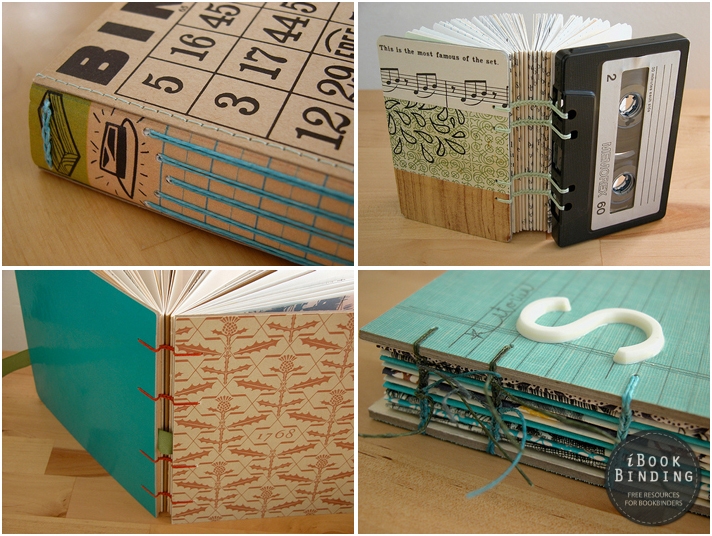09. Bookbinding Projects
Manuscript Binding
A manuscript binding is a style in which single sheets are pasted at the edges in pairs, creating folds for sewing. The edges of the front sheets are pasted onto the edges of the corresponding back sheets, and are then folded down into a single signature.

Take about ten sheets of paper, or any other number that is even. Divide them into two sections, each containing an equal number of sheets. Lay these sheets on the workbench with the front sheets facing down on the surface and the back sheets facing towards you. See figure 149 for guidance. Mark a distance of one fourth of an inch on the back of every sheet. This will be required for trimming down the back sheets, but the front ones are left as they are.

Align the bundle comprising of the back sheets and place them on a flat surface. Place a carpenter’s square on the sheets, aligning it up with the edges as shown in figure 150. With a sharp knife, trim down the sheets along the edge of the square while keeping it fixed in its position.
Now take a fresh sheet of wastepaper and lay it down on the manuscript sheet. Ensure that the edge of the wastepaper is parallel to the pencil marks in the sheets. This is depicted in figure 151. Keep your fingers firmly onto the wastepaper so that it does not slip from its position, and apply a thin layer of paste on the edge of the manuscript; throw off the soiled paper after this. With clean hands, take the corresponding back sheet and place it onto the layer of the paste. Align the sheet with the mark guide as shown in figure 152, and press it down. In this same manner, paste together every half of sheet, and leave your work for drying.
Place the endsheets on the manuscript, the sheets of which should be in the correct sequence as shown in figure 153. Jog the sheets and align them together; then fold them into a single signature. Place the signature on a piercing board with the mull on the top side as shown in figure 154. Pierce holes through the signature and sew it up as shown in figure 155. Cut off the mull until its width on each of the sides is about an inch; paste it down with tapes as illustrated in figure 156. This completes the manuscript; let it dry for twelve hours.
How to Make & Use A Piercing Template
Don't forget to subscribe to our YouTube channel to get access to HD videos of hundreds of Book Binding tutorials and reviews!
Square Back Case

A square back case, illustrated in figure 157, is a separate unit that is used for binding machine made books. The signatures for this project can easily be formed with the standard procedure that has been followed throughout this manual. However, the cover boards are made in a slightly different manner.
Make the cover boards of a size that is one eighth of an inch greater than the signature size on each edge. Rub sandpaper onto the edges to round them off. Place the signatures between the front and back boards, and measure the total width of the binding using a strip of paper as shown in figure 158. Using this measurement, cut out a piece of the cover boards for the backbone. Rub sandpaper on this board as well, and then align it with the signature, clamping the two together with a strip of taped paper as depicted in figure 159. Form firm creases along the edges of the paper and remove it to reveal a layout as shown in figure 160.
Transfer the layout onto the backside of the covering material. Place the cover board onto the sketched layout and mark a distance of half an inch from the edges. This will be used for the turnovers. Cut the covering material against the newly marked edges. Paste the covering material onto the boards, mitre the corners, fold down the turnovers, press your work firmly and leave it for drying.
Now the case has to be attached to the signatures. Apply the paste onto the mull as shown in figure 161. Place the signature onto the back cover board; keep it slightly lifted, and adjust its position so that it aligns with the edges of the square board as demonstrated in figure 162. Then carefully press it down on the surface and remove air bubbles if any. Let your work dry for a few minutes. Attach the front cover in the same manner. This is shown in figure 163.

When you have attached the front and back covers, inspect the backbone board. Ascertain that this forms a ninety degree angle with both the front and back boards; you can confirm this with a right angled card as shown in figure 164.
Open the covers again, and rub the covering material to remove any remaining air bubbles. Let your work dry for an hour, and then attach the endsheets. Place weights onto the square binding, and let it dry for the whole night.
Please Support us on Patreon!

Moreover, starting with the pledge level of $3, you will get a digitized vintage book about bookbinding, book history, or book arts each month from us!
These pledges help iBookBinding to continue its work and bring more information about bookbinding and book arts to you!















